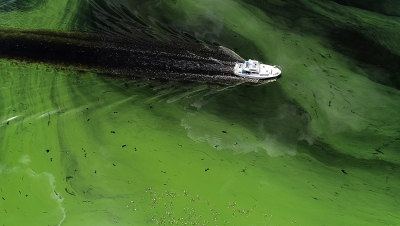
A deadly bloom has hit Chile, where more than 4,200 tonnes of fish have been killed. It’s the latest mass mortality event recorded in Chile, the second largest salmon producer after Norway.
Some 18 salmon farms in the south of Chile, which produces around 26% of the world’s salmon, have been affected.
Scientists attribute the die-off to algal blooms that reduce the amount of oxygen in water, thus suffocating the salmon. The same phenomenon killed thousands of tones of salmon in 2016.
Greenpeace, the international environmental organisation, says the algal bloom is due to pollution caused by salmon farming. Emission of ammonium and urea from salmon farms into closed fjords or with little circulation can exacerbate blooms, it points out.
What is algal bloom?
When the normally occurring aquatic algae reproduce faster and grow out of control, it is called algal bloom. It may turn waterbodies orange, yellow, brown or purple depending on the algae species in question. Some of the blooms have the potential to be harmful.
Combination of factors
The blooms are caused by a combination of factors: high concentrations of nutrients that feed algae, warm temperatures, sunlight and shallow, slow-flowing water.
When humans channel agricultural runoff, sewage and industrial effluents into waterways, the amount of nutrients in the water increases. the excess nutrients, especially nitrogen and phosphorous, lead to a spurt in the growth of microscopic algae called phytoplankton.
Algal bloom often happens during the warm summer season or when water temperatures are warmer than usual. Warmer temperatures make water stagnant, thus allowing algae to grow thicker and faster. Further, algal blooms absorb more sunlight, making water even warmer and promoting more blooms.
In different ways
Not all algal blooms are harmful, but some are deadly. They affect the marine ecosystem in different ways. First, the physical presence of so many algae may suffocate fish by clogging or irritating the gills. Second, phytoplanktons use up all the nutrients, grow, die and sink to the bottom, where they are decomposed by bacteria. The bacteria respire using the dissolved oxygen in the water, leading to the depletion of oxygen available for other marine organisms, which eventually suffocate and die. Third, some algal species produce deadly toxins which either kill the animals or accumulate in the body of animals and spread through the food web.
Picture Credit : Google



